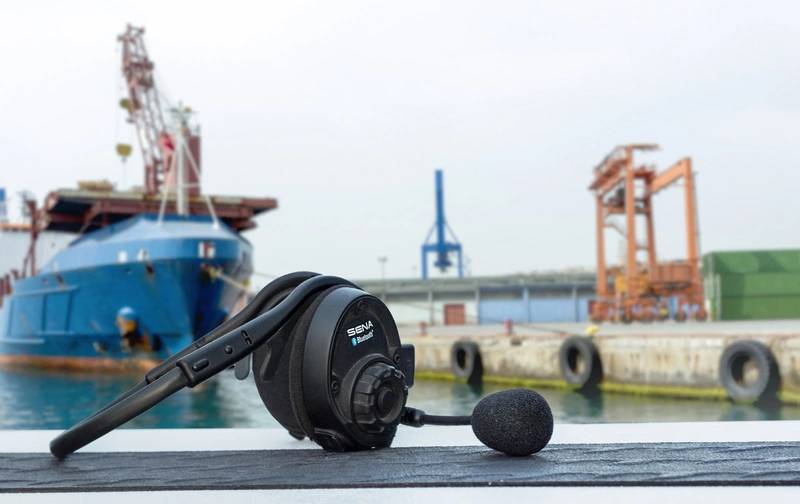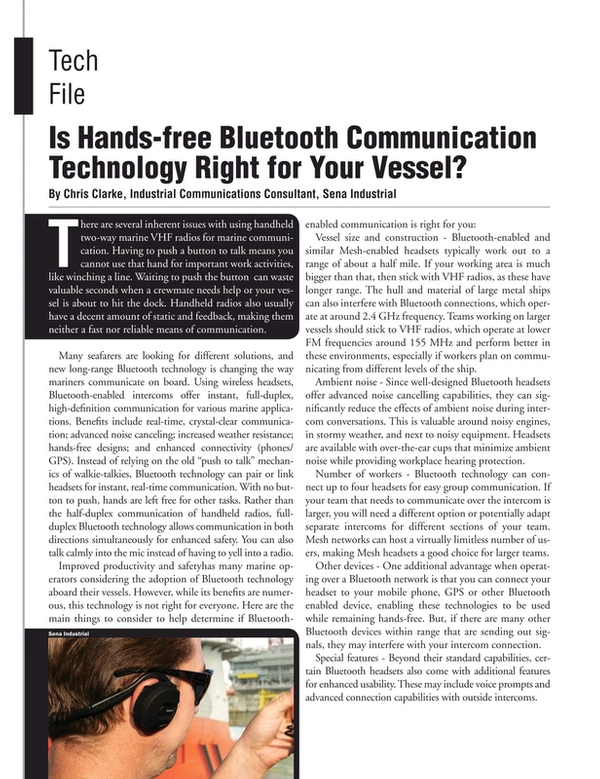
Is Hands-free Bluetooth Communication Right for Your Vessel?
How do you handle communication on your vessel? If you are like many others, you probably use handheld two-way marine VHF radios. That, or simply yelling.
There are several inherent issues with using handheld radios for marine communication. Having to push a button to talk means that you cannot use that hand for important work activities, like winching a line or turning the wheel. Since you have to wait to push the button, you can waste valuable seconds when a crewmate needs help or your ship is about to ram into the dock. Handheld radios also usually have a decent amount of static and feedback, making them neither a fast nor reliable means of communication.
That is why many seafarers are looking for a different solution. Today, new long-range Bluetooth technology is changing the way people communicate with each other during marine operations. Using wireless headsets, these Bluetooth-enabled intercoms offer instant, full-duplex, high-definition communication fit for a variety of nautical applications. Benefits include real-time, crystal-clear communication; advanced noise canceling; increased weather resistance; hands-free designs; and enhanced connectivity (phones/GPS).
Instead of relying on the old “push to talk” mechanics of walkie-talkies, Bluetooth technology can pair or link headsets for instant, real-time communication. Without having to push a button, you leave your hands free for other tasks. Rather than the half-duplex communication of handheld radios, full-duplex Bluetooth technology allows communication in both directions at the same time for enhanced safety. You can also talk calmly into the mic instead of having to yell into a radio, making this technology perfect for the coast guard auxiliary because they can talk quietly while approaching a suspicious vessel.
By improving productivity and safety aboard marine vessels, Bluetooth technology has many people considering its adoption. However, while there are numerous benefits, this technology is not right for everyone.
 Long-range Bluetooth headsets, like the Sena SPH10 shown here, are an alternative to radios for small work teams in marine environments. (Photo: Sena Industrial)
Long-range Bluetooth headsets, like the Sena SPH10 shown here, are an alternative to radios for small work teams in marine environments. (Photo: Sena Industrial)
Here are the main things to consider to help determine if Bluetooth-enabled communication is right for you:
Vessel size and construction - Bluetooth-enabled and similar Mesh-enabled headsets typically work out to a range of about a half mile. If your working area is much bigger than that, then stick with VHF radios, as these have longer range.
The hull and material of large metal ships can also interfere with Bluetooth connections, which operate at around 2.4 GHz frequency. Teams working on larger, bulkier vessels should stick to VHF radios, which operate at lower FM frequencies around 155 MHz and perform better in these environments, especially if workers plan on communicating from different levels of the ship.
Ambient noise - Since well-designed Bluetooth headsets offer advanced noise cancelling capabilities, they can significantly reduce the effects of ambient noise during intercom conversations. This is valuable around noisy engines, in stormy weather, and next to noisy equipment. Also, headsets are available with over-the-ear cups that minimize ambient noise while providing workplace hearing protection.
Number of workers - With Bluetooth technology, you can connect up to four headsets together for easy group communication. If your team is larger than four people, specifically in regards to who needs to communicate over the intercom, then you will need to pick a different option or potentially adapt separate intercoms for different sections of your team. Mesh networks can host a virtually limitless number of users, making Mesh headsets a good choice for larger teams.
Other devices - One additional advantage that you have when operating over a Bluetooth network is that you can connect your headset to your mobile phone, GPS, or other Bluetooth enabled device. That way, you can use these other technologies while still staying hands-free. However, if there are many other Bluetooth devices within range that are sending out signals, then they may interfere with your intercom connection.
Special features - Beyond their standard capabilities, certain Bluetooth headsets also come with additional features for enhanced usability. These may include voice prompts and advanced connection capabilities with outside intercoms. If the above considerations fit your needs, then hands-free Bluetooth communication technology may be right for you.
The author
Chris Clarke is an industrial communications consultant at Bluetooth communication specialist Sena Industrial.
Read Is Hands-free Bluetooth Communication Right for Your Vessel? in Pdf, Flash or Html5 edition of April 2021 Marine News
Other stories from April 2021 issue
Content
- US Jobs from US Offshore Energy: A Goal 44 Years in the Making page: 18
- 2021: A Year of Offshore Energy Potential page: 20
- Ready Your Salad Fork for Biden’s Offshore Energy Plans page: 22
- A Favorable Fetch for US Offshore Wind page: 24
- Expert Advice: New Ballast Water Guide page: 30
- How Racing Tech Will Set Up US Offshore Vessel Operators for Success page: 36
- Is Hands-free Bluetooth Communication Right for Your Vessel? page: 38


